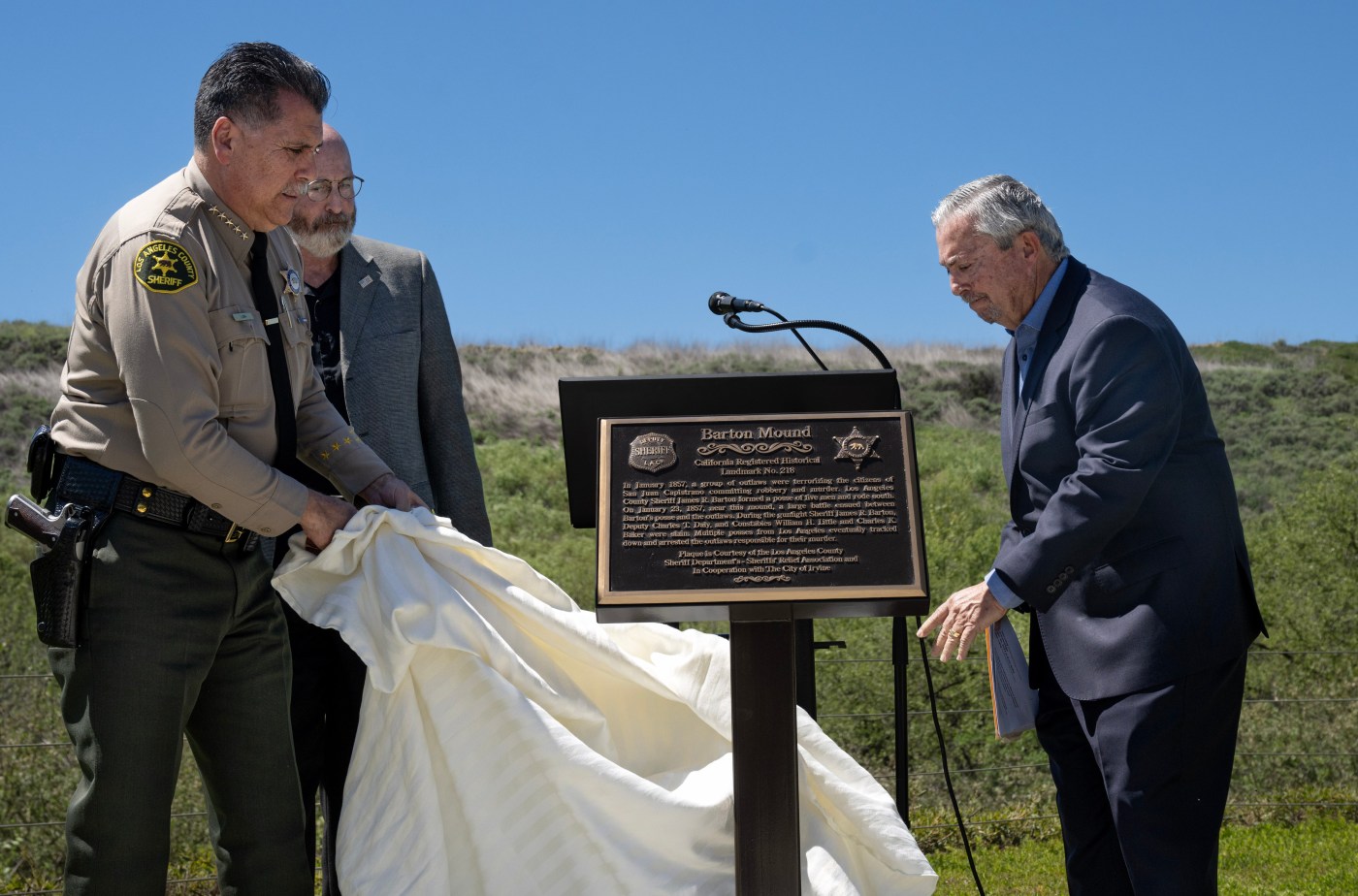On Jan. 23, 1857, notorious horse thief Juan Flores and his gang of bandits engaged in a fierce gun battle with Los Angeles County law enforcement officers who were in pursuit of them, killing four.
The officers, LA County Sheriff James Barton, Deputy Charles Daly and Constables William Little and Charles Baker, were on horseback en route south to San Juan Capistrano after receiving word that a band of robbers was threatening the safety of residents of the mission town. But they did not know that the group had been alerted that Barton and his men were coming for them and had devised a plan to ambush them.
Barton, Daly, Little and Baker lost their lives in the line of duty on a mound of land near the 405 and State Highway 133 interchange and the Spectrum Center, dubbed Barton Mound.
In the 167 years since their murders, highways, cars and housing have taken over the wide plains in what is now Irvine, where those four men on horseback were shot to death. The site was designated a California historical landmark on June 20, 1935.
And on Monday, April 1, nearly a century after that designation, a metal plaque commemorating their bravery was unveiled in front of the rolling hills where the shootout took place.
“As we look around us this afternoon, it is hard to imagine what Southern California was like over 140 years ago and how the people of that time lived,” said retired Los Angeles Sheriff’s Department Lt. John Stanley. “The land all around us was largely rolling empty grasslands. But in January 1857, danger for its residents also lurked all around them in that seemingly pristine setting.”
In the 1850s in Orange County — which was then a part of Los Angeles County until 1889 — law was loose and chaos and violence were aplenty.
There was little presence of law enforcement in the vast county, almost the size of Maine, which included all or parts of present-day Kern, San Bernardino and Orange counties, Stanley said.
That, coupled with the resentment felt by Mexican Californians due to many rancheros losing land they had owned prior to the signing of the Treaty of Guadalupe Hidalgo (ending the Mexican-American War and giving California to the U.S.), resulted in largely unbridled gang activity and violence between non-Hispanic settlers to the region and the indigenous people who inhabited the land, of which Flores and his gang played a prominent role, said Stanley.
Throughout the last two months of 1856, Stanley said, Flores and his gang, who called themselves “Las Manillas,” which translates to “the Handcuffs,” harassed residents of central and southern California.
A convicted horse thief who had escaped from San Quentin Prison, Flores rode to San Juan Capistrano with his gang where they committed robbery and murder in January 1857, resulting in the death of German tavern owner George Pflugardt.
Barton and five other men — including two he deputized: blacksmith Charles T. Daly and wagon driver Alfred Hardy — traveled south en route to San Juan Capistrano, planning to apprehend Flores and his gang and put a stop to their reign of terror in the region, said Stanley.
But when they got to the area that is now surrounded by apartment homes and a portion of the San Diego Creek pedestrian trail, they were ambushed by Flores and his group. Only Daly and Hardy survived.
Related Articles
Shredding through time: How skateboarding has evolved in Orange County
Flores and the rest of the bandits, except for the man who killed Barton who fled to Mexico, were eventually captured by large companies of men who pursued them and killed, said Stanley.
“Even though this was many, many years ago … at the end of the day, you need men and women to do what the sheriff did back then and what our men and women in uniform are doing every day today,” said LA County Sheriff Robert Luna. “This means we never forget, we will always honor those who protect our community, and more importantly, give their lives for our community.”
Tom Laing, a retired chief of the LA County Sheriff’s Department who spearheaded the effort to install the plaque, said it was purchased by the Sheriffs’ Relief Association, a private organization that supports the LA County Sheriff’s Department, and no taxpayers’ or LA County Sheriff’s public funds were used.
Irvine Councilmember Mike Carroll — who, with former Councilmember Anthony Kuo, proposed the installation of the plaque in 2021— said the site will be added to the tours of Old Town Irvine that the Irvine Historical Society holds every month.





